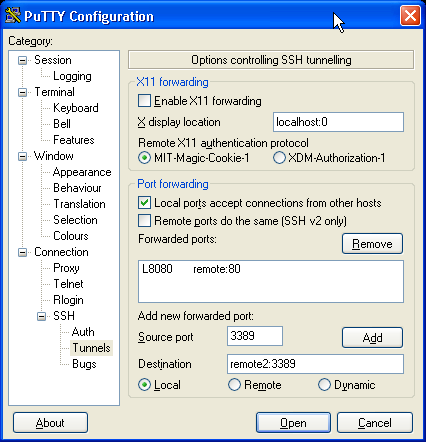
In order to access your server via SSH tunnel you need an SSH client.
PUTTY PORT FORWARDING WINDOWS
Access a server using an SSH tunnel on Windows IMPORTANT: Before following the steps below, ensure that your application server is running. In case you need to access a server on a specific port remotely, Bitnami recommends creating an SSH tunnel instead of opening the port in the server firewall.ĭepending on your operating system, follow these instructions to create an SSH tunnel and ensure secure access to the application. Troubleshoot server performance problemsīitnami strongly discourages you from opening server ports apart from those defined by default.Enable SSL access over HTTPS with Cloudflare.Understand the message "AWS instance scheduled for retirement".Auto-configure a Let's Encrypt certificate.Modify the AWS instance type or CPU/memory configuration.
PUTTY PORT FORWARDING INSTALL
Install and use the Amazon CloudWatch agent.Give SSH access to another person, such as a customer.Learn about the Bitnami Configuration Tool.Configure third-party SMTP for outbound emails.Reassociate an existing IP address with a new AWS instance.Understand what data Bitnami collects from deployed Bitnami stacks.Learn about Bitnami PHP application modules deprecation.Understand the default directory structure.Learn about the SSH warning 'REMOTE HOST IDENTIFICATION HAS CHANGED'.Which allows to your access services running on remote system or network via SSH network, where you don’t have directly access via port. This tutorial helped you to setup local and remote SSH tunnel via the Putty application on Windows server. Next, In the Destination field, enter the destination address followed by the port number.In the Source port field, enter the port number to use on your local system.Select Remote to define the type of SSH port forward.Remote forwarding represents an inversion of the local forwarding process as described above. The Remote forwarding allows a remote system to access resources from your local machine. The tunnel will work until the SSH session is active Connect the SSH session to make the tunnel. Verify the details you added and press Add button.Select Local to define the type of SSH port forward.Navigate to the Connection > SSH > Tunnels. In the left sidebar under the Category options.


Make sure the connection type is set to SSH.Īdd hostname of the SSH server you want to access remotely. In the Session windows, enter the hostname or IP address and port number of the destination SSH server.

The Tunnel provides you port forwarding from both sides. Once you forwarded your localhost port to the port listening on remote network, you can directly access the the remote service by accessing configured port with localhost. With the help of SSH tunnel you can access resources available on other ports, which is not directly accessible from your system. It also provides you option to create SSH tunnel to provide access to resource within the trusted internal network. Most of the Linux system users are aware and use to connect remote system running SSH server. PuTTy is a user-friendly SSH client for the Windows system.


 0 kommentar(er)
0 kommentar(er)
